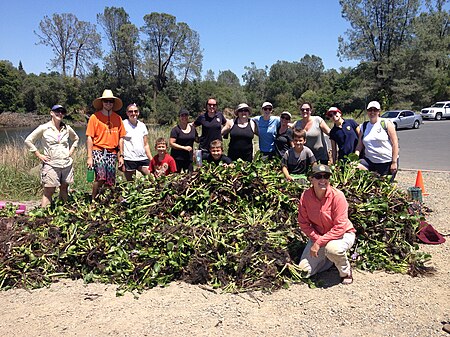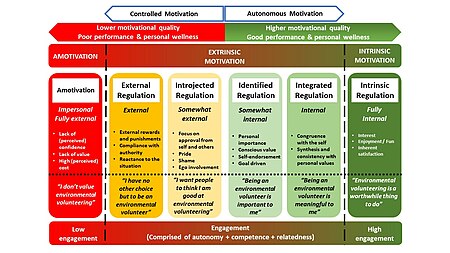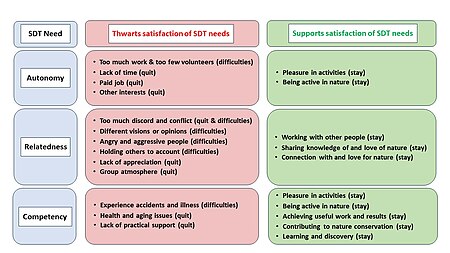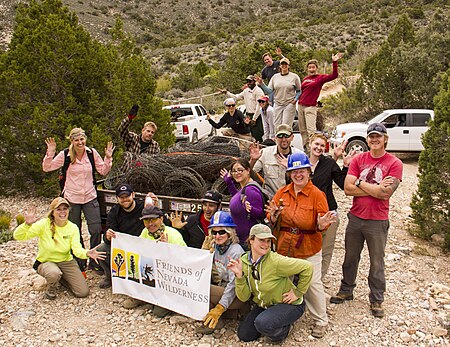Motivation and emotion/Book/2023/Environmental volunteering motivation
What motivates environmental volunteering?
Overview
[edit | edit source]In countries like Australia, the number of people volunteering has declined over the past 10 years, and the COVID-19 pandemic made this situation even worse (Davies, 2023). This chapter addresses the focus questions below so that those working with environmental volunteers can hopefully engage and keep their volunteers coming back for more (and invite a few of their friends as well!). Examples are used illustrate putting the approaches into practice.
|
Focus questions
|
Motivation and environmental volunteering
[edit | edit source]Being moved to do something, by our needs, thoughts and emotions, is to be motivated (Reeve, 2018; Ryan & Deci, 2000). Motivation is an internal desire or want to change ourselves or our situation (Reeve, 2018). Motivation also concerns the direction, energy, and persistence of our behaviour (Reeve, 2018).
Volunteering has the following three core elements (Measham & Barnett, 2008; Volunteering Australia, 2015):
- willing to give time
- acting for the common good
- contributing without financial gain

Environmental volunteering involves achieving environmental gains through the engagement of volunteers, and includes (O'Brien et al., 2010):
- hands-on conservation work
- education and public outreach
- coordinating activities
- monitoring presence and distribution of species
Environmental volunteers include environmental citizen scientists who undertake activities such as (Maund et al., 2020):
- collecting scientific data, often over long time frames and large geographical areas
- proposing research questions
- analysing data
- sharing results
- contributing to environmental protection
How does theory explain what motivates environmental volunteers?
[edit | edit source]A theory provides a valid and evidence-based conceptual framework to explain and test ideas about what motivates environmental volunteers (Ryan & Deci, 2017). Kragt and Holtrop (2019) note that:
- many Australian volunteering studies lack any reference to theory, and
- this may be due to the lack of a single integrated theory of volunteering.
West et al. (2021) provide an overview of how motivational categories of volunteering relate to each other (see Figure 2).
Kath and Kim have been close friends for years and live in different towns a couple of hours drive from each other. Being interested in environmental issues, they want to do something to help the environment. They decide to join a local environmental group as volunteers. Kath wants to see if being an environmental volunteer helps her learn more about environmental issues. Kim is looking forward to meeting people with similar interests from her community. Which factors from the volunteer functions inventory described below best capture the motivations of Kath and Kim? |
Volunteer functions inventory
[edit | edit source]
The Volunteer Functions Inventory (VFI, see Figure 3) (Clary & Snyder, 1999; Clary et al., 1998) includes the following six functions:
- values
- career
- enhancement
- understanding
- social
- protective
Key things to note about the VFI functions include (Clary & Snyder, 1999; Stukas & Wilson, 2022):
- different volunteers may perform the same actions to meet different motives,
- volunteers may be addressing two or more motives at the same time, and
- the VFI is not a definitive list of every possible motive.
The VFI is one of the most frequently used methods in studies of environmental volunteer motivation (West et al., 2021). This is due to its reliability and being easy to use (Heimann & Medvecky, 2022).
In examining the motivations of environmental citizen scientists in Great Britain, West et al. (2021), found the "values" motivation was the most common. Motivations relating to "career", "understanding" and "values" are often combined for younger volunteers (West et al., 2021). West et al. (2021) recommend:
- Matching the motivations of environmental volunteers to recruitment materials and project tasks.
- Checking in with your volunteers to see if their motivations are changing over time. If so, adjust project tasks to continue matching them with changes in motivations.
- Providing regular feedback to your volunteers in ways that aligns with their "values" motivations.
Bruyere and Rappe (2007) used a modified VFI approach involving environmental volunteers near Colorado State University. They found that:
- "help the environment" was the strongest motivational factor,
- "career" was the weakest motivational factor, and
- the motivational factor "get outside" emerged from responses to an open-ended question in their survey.
In a study involving environmental volunteers in New Zealand, Heimann and Medvecky (2022) further modified the VFI approach used by Bruyere and Rappe (2007) by including survey questions related to "community" and "get outside". Heimann and Medvecky (2022) found that:
- "help the environment", "get outside" and "community" were the three strongest motivations, and
- "career" was again the weakest motive.
Stukas and Wilson (2022) note some limitations of the VFI approach, including:
- Studies using the VFI tend to look at motives in isolation, in competition with each other, or additive.
- The need to consider demographic factors with the VFI, particularly those related to age, health, family and paid work.
- The VFI does not assist with identifying self- or other-oriented motivations to volunteer.
Studies that have included demographic factors with VFI (Heimann & Medvecky, 2022; West et al., 2021) found that environmental volunteer groups often lack cultural and social diversity.

The key messages from the VFI approach include:
- It is a widely adopted and easy to use method.
- The approach is flexible in enabling additional factors to be included with the core VFI factors.
- Open-ended questions are key to identifying new factors of relevance to environmental volunteers.
See the external links to the NZ Conservation Volunteer Survey (Heimann & Medvecky, 2022) and the 30 question VFI scale (Clary et al., 1998).
Quiz time!
It’s been over 12 months since Kath and Kim became environmental volunteers and they are both loving the experience. Kath’s group now has a paid coordinator. Kath reflects that this can help take the pressure off the volunteers to organise things. However, sometimes it can feel like the group is not responsible for what activities it undertakes. Kim reflects that her biggest challenge is not being able to do more difficult tasks as she has not had training in how to do them. Which factors from the theory of planned behaviour described below best capture the motivations of Kath and Kim? |
Theory of planned behaviour
[edit | edit source]
The theory of planned behavior (TPB) is a decision-making model (see Figure 5, adapted from Ajzen (2019)).
It has the following three elements that predict behavioural intentions (Brayley et al., 2015):
- attitudes
- subjective norms
- perceived behavioural control
Ajzen (1991) and Brayley et al. (2015) suggest that a person’s intentions or actions are determined by the following salient beliefs (see Figure 5, adapted from Ajzen (2019)):
- behavioural beliefs
- normative beliefs
- control beliefs
As shown in Figure 5, the TPB approach notes the following points in explaining the motivation to undertake a behaviour (Ajzen, 2020):
- it emerges from approving subjective norms and positive attitudes,
- a strong perception of control over a behaviour is critical to forming a strong intention to engage in a behaviour,
- intentions capture how much effort someone is willing to commit to perform a behaviour, and
- actual behavioural control reflects how the resources a person has (e.g., time and money) can determine how likely it is they will perform a behaviour.
Hauser et al. (2012) used TPB to examine participation in environmental volunteering across 11 catchments in Ohio, United States. Using an extended TPB model (included demographic influences, identification with group, and personal request), Hauser et al. (2012) found:
- a personal request to take part in the tasks was the most significant factor,
- the inclusion of extra variables resulted in subjective norm having the second largest impact on results,
- perceived behavioural control having no significant effect, and
- support for using TPB to describe volunteer participation, but adding extra variables improved the model.
The key message from the study by Hauser et al. (2012) is that social connections influence the participation of environmental volunteers.

Gulliver et al. (2023) examined the variables associated with environmental volunteer leadership behaviours in Australia. Using an extended TPB model (included self-efficacy, collective efficacy, environmental identity, organizational climate, and organizational commitment), Gulliver et al. (2023) found that:
- none of the core TPB variables emerged as significant predictors,
- self-efficacy was a primary variable in predicting environmental volunteer participation and leadership, and
- identification as an environmental volunteer was also an important variable in predicting participation behaviours.
The key message from Gulliver et al. (2023) is that there appears to be a relationship between volunteers' belief in their ability to undertake actions, and the extent of their engagement.
Kragt and Holtrop (2019) note the potential to combine the TPB with the VFI. Brayley et al. (2015) used this approach with business/administration volunteers and found that the "understanding" function from the VFI was a significant predictor of volunteering when combined with the core TPB variables.
The use of a combined TPB-VFI approach for environmental volunteering appears to be a research gap. Future research could also examine how the activity of volunteering potentially impacts the influence of perceived behavioural control in the TPB model.
In summary, the core TPB model (Brayley et al., 2015; Gulliver et al., 2023; Hauser et al., 2012):
- has limitations in explaining the motivations of environmental volunteers, and
- is open to improvement by including "social" and "understanding" factors from the VFI.
See external links for a guide on how to construct a TPB questionnaire (Ajzen, n.d.).
Quiz time!
Kath and Kim are now three years into their journey as environmental volunteers. As part of her group Kim now organises a citizen science project that monitors native frogs in their area. Kim has become passionate about frog conservation as a result of her volunteering efforts. Kath is also helping her group to get involved in a citizen science project which monitors native birds. Kath had no idea there were so many bird lovers in her group until she proposed the project! Which elements of self-determination theory described below best capture the motivations of Kath and Kim? |
Self-determination theory
[edit | edit source]
Deci et al. (2017) describe self-determination theory (SDT, see Figure 7) as a organismic theory focused on human motivation. The six mini-theories included within SDT are (Ryan & Deci, 2017):
- Cognitive evaluation theory
- Organismic integration theory
- Causality orientations theory
- Basic psychological needs theory concerns the needs listed below and their relationship to well-being.
- autonomy: the feeling that behaviour is self-endorsed or aligned with ones interests and values (often confused with being independent or self-reliant)
- relatedness: the feeling of social connectedness, belonging, and being a valued member of a group.
- competence: the feeling of mastery and operating effectively when undertaking behaviour that matters.
- Goal contents theory
- Relationships motivations theory
Ganzevoort and van den Born (2023) used SDT to explore:
- the difficult situations experienced by Dutch nature volunteers,
- their reasons to stay or quit as volunteers, and
- how these reasons relate to autonomy, relatedness and competence needs described in SDT.
In their study Ganzevoort and van den Born (2023):
- Note the limitations of pre-existing scales in:
- not addressing their research questions, and
- no design tailored for nature volunteers.
- Opted to use four open ended questions included as part of a broader survey.
- Analysed 3,775 responses (approximately 2,000 responded to all four questions) by:
- categorising response using an inductive qualitative coding approach, and
- using the SDT descriptions of autonomy, competence and relatedness to classify the main themes in the responses, as summarised in Figure 8 below.

The key findings from Ganzevoort and van den Born (2023) include:
- The categories identified aligned with the SDT basic needs of autonomy, competence and relatedness.
- Given its importance to environmental volunteers, “nature connectedness” needs to be incorporated into the SDT need of relatedness, not just relatedness to other people.
- To improve autonomy, enable environmental volunteers to:
- choose what they want to do,
- be able to express why they want to do their chosen activity, and
- have defined roles.
- To improve relatedness (both nature and social relatedness):
- offer different options for volunteers to socialise with each other,
- offer practical support, and
- give acknowledgement and appreciation of volunteer’s efforts.
- Providing positive feedback on the contributions and value of volunteer efforts can support the satisfaction of competence needs.
- Future research could examine:
- how “volunteerability” (one’s availability of time, combined with willingness and capability) can be further incorporated into SDT, and
- the linkages between meaningfulness and relatedness.

Stukas and Wilson (2022), agree with the key findings from Ganzevoort and van den Born (2023), and note that the SDT basic needs are implied in the six functions of the VFI (Clary & Snyder, 1999).
Like TPB, compared to VFI there are much fewer published findings on the application of SDT in relation to environmental volunteering (Ganzevoort & van den Born, 2023).
The use of a combined SDT-TPB approach for environmental volunteering also appears to be a research gap. Grano et al. (2008) applied this approach in a study on older Italian volunteers finding that motivations from SDT could contribute significantly to TPB variables. Future research using SDT could also include consideration of the motives of environmental volunteers across all six of the SDT mini theories, rather than focusing on the basic psychological needs mini theory.
The external links include a link to the SDT motivation to volunteer scale (Grano et al., 2008).
Quiz time!
Conclusion
[edit | edit source]
To meet the needs of environmental volunteers, organisers need to know and understand their motivations over time (Stukas & Wilson, 2022; West et al., 2021)
In relation to using the VFI to explain what motivates environmental volunteering:
- Those who manage environmental volunteers may find the VFI an easy to use and reliable way to develop an understanding of what motivates their volunteers (West et al., 2021).
- "Values" motivations are key to environmental volunteers (West et al., 2021),
- Individual volunteers may have many motives at the same time (Stukas & Wilson, 2022)
- Open-ended questions are valuable in identifying extra motives (e.g., "get outside", "community" and "help the environment") that are also important to environmental volunteers (Bruyere & Rappe, 2007).
- Demographic information is critical in determining how these factors relate to key motives for different volunteers (Stukas & Wilson, 2022).
- Maintained research effort continues to refine the VFI approach, which in turn maintains its currency when applied in the field (Heimann & Medvecky, 2022).
In relation to using the TPB to explain what motivates environmental volunteering:
- This approach appears to need the inclusion of additional factors (e.g., personal request to participate, being identified as an environmental volunteer (Hauser et al., 2012), and self-efficacy (Gulliver et al., 2023)) to be able to explain what motivates environmental volunteers.
- Core components of the approach (e.g., perceived behavioural control) appear to be less significant for environmental volunteers compared to additional factors (Gulliver et al., 2023; Hauser et al., 2012).
In relation to using the SDT to explain what motivates environmental volunteering:
- The alignment of SDT basic needs of autonomy, competence and relatedness and the motivational categories identified from environmental volunteers is possible (Ganzevoort & van den Born, 2023).
- The use of open-ended questions appears to be an important way of identifying extra factors, such as “nature connectedness”, that may be unique to environmental volunteers (Ganzevoort & van den Born, 2023).
All three approaches are flexible in trying to explain the motives of environmental volunteers. SDT appears to be well positioned as a broader, macro theory which other approaches could integrate into (Ganzevoort & van den Born, 2023; Stukas & Wilson, 2022).
The emergence of citizen scientists as a large and active sub-group within environmental volunteers is also likely to continue to be a focus of future research (West et al., 2021). Addressing the broader question of What motivates citizen scientists? could be an interesting topic for a future Motivation & Emotion book chapter.
See also
[edit | edit source]- Environmental volunteering (Wikipedia)
- Environmental volunteering motivation (Book chapter, 2022)
- Motivation (Wikipedia)
- Self-determination theory (Wikipedia)
- Theory of planned behaviour (Wikipedia)
- Volunteer functions inventory (Wikipedia)
References
[edit | edit source]Ajzen, I. (2019). Theory of planned behavior diagram, University of Massachusetts Amherst https://people.umass.edu/aizen/tpb.diag.html
Ajzen, I. (2020). The theory of planned behavior: Frequently asked questions. Human Behavior and Emerging Technologies, 2(4), 314–324. https://doi.org/10.1002/hbe2.195
Ajzen, I. (n.d.). Constructing a theory of planned behaviour questionnaire, https://people.umass.edu/aizen/pdf/tpb.measurement.pdf
Batson, C. D., Ahmad, N., & Tsang, J. A. (2002). Four motives for community involvement. Journal of Social Issues, 58(3), 429–445. https://doi.org/10.1111/1540-4560.00269
Brayley, N., Obst, P. L., White, K. M., Lewis, I. M., Warburton, J., & Spencer, N. M. (2015). Examining the predictive value of combining the theory of planned behaviour and the volunteer functions inventory. Australian Journal of Psychology, 67(3), 149–156. https://doi.org/10.1111/ajpy.12078
Bruyere, B., & Rappe, S. (2007). Identifying the motivations of environmental volunteers. Journal of Environmental Planning and Management, 50(4), 503–516. https://doi.org/10.1080/09640560701402034
Clary, E. G., & Snyder, M. (1999). The motivations to volunteer: theoretical and practical considerations. Current Directions in Psychological Science, 8(5), 156–159. https://doi.org/10.1111/1467-8721.00037
Clary, E. G., Snyder, M., Ridge, R. D., Copeland, J., Stukas, A. A., Haugen, J., & Miene, P. (1998). Understanding and assessing the motivations of volunteers: a functional approach. Journal of Personality and Social Psychology, 74(6), 1516–1530. https://doi.org/10.1037/0022-3514.74.6.1516
Davies, A. (2023, May 17). How can we bolster Australia’s depleted army of volunteers to match the soaring demand for their services? The Conversation, https://theconversation.com/how-can-we-bolster-australias-depleted-army-of-volunteers-to-match-the-soaring-demand-for-their-services-205218
Deci, E. L., Olafsen, A. H., & Ryan, R. M. (2017). Self-determination theory in work organizations: the state of a science. Annual Review of Organizational Psychology and Organizational Behavior, 4(1), 19–43. https://doi.org/10.1146/annurev-orgpsych-032516-113108
Finkelstien, M. A. (2009). Intrinsic vs. extrinsic motivational orientations and the volunteer process. Personality and Individual Differences, 46(5), 653–658. https://doi.org/https://doi.org/10.1016/j.paid.2009.01.010
Ganzevoort, W., & van den Born, R. J. G. (2023). The everyday reality of nature volunteering: an empirical exploration of reasons to stay and reasons to quit. Journal of Environmental Planning and Management, 1–20. https://doi.org/10.1080/09640568.2023.2240953
Grano, C., Lucidi, F., Zelli, A., & Violani, C. (2008). Motives and determinants of volunteering in older adults: an integrated model. International Journal of Aging & Human Development, 67(4), 305–326. https://doi.org/10.2190/AG.67.4.b
Gulliver, R. E., Fielding, K. S., & Louis, W. R. (2023). An investigation of factors influencing environmental volunteering leadership and participation behaviors. Nonprofit and Voluntary Sector Quarterly, 52(2), 397–420. https://doi.org/10.1177/08997640221093799
Hauser, B. K., Koontz, T. M., & Bruskotter, J. T. (2012). Volunteer participation in collaborative watershed partnerships: insights from the theory of planned behaviour. Journal of Environmental Planning and Management, 55(1), 77–94. https://doi.org/10.1080/09640568.2011.581535
Heimann, A., & Medvecky, F. (2022). Attitudes and motivations of New Zealand conservation volunteers. New Zealand Journal of Ecology, 46(1), 1–13. https://doi.org/10.20417/nzjecol.46.18
Kragt, D., & Holtrop, D. (2019). Volunteering research in Australia: a narrative review. Australian Journal of Psychology, 71(4), 342–360. https://doi.org/10.1111/ajpy.12251
Maund, P. R., Irvine, K. N., Lawson, B., Steadman, J., Risely, K., Cunningham, A. A., & Davies, Z. G. (2020). What motivates the masses: Understanding why people contribute to conservation citizen science projects. Biological Conservation, 246, 108587–108587. https://doi.org/10.1016/j.biocon.2020.108587
Measham, T. G., & Barnett, G. B. (2008). Environmental volunteering: motivations, modes and outcomes. Australian Geographer, 39(4), 537–552. https://doi.org/10.1080/00049180802419237
O'Brien, L., Townsend, M., & Ebden, M. (2010). 'Doing something positive': volunteers' experiences of the well-being benefits derived from practical conservation activities in nature. Voluntas (Manchester, England), 21(4), 525–545. https://doi.org/10.1007/s11266-010-9149-1
Reeve, J. (2018). Understanding motivation and emotion (Seventh edition. ed.). Hoboken, NJ: Wiley.
Ryan, R. M., & Deci, E. L. (2000). Intrinsic and extrinsic motivations: classic definitions and new directions. Contemporary Educational Psychology, 25(1), 54–67. https://doi.org/10.1006/ceps.1999.1020
Ryan, R. M., & Deci, E. L. (2017). Self-determination theory: basic psychological needs in motivation, development, and wellness. New York, NY: The Guilford Press. https://doi.org/10.1521/978.14625/28806
Stukas, A., & Wilson, S. (2022). Understanding motivations to volunteer. https://volunteeringstrategy.org.au/VRP_Understanding-Motivations-to-Volunteer
Volunteering Australia. (2015). Volunteering Australia’s definition of volunteering: frequently asked questions. https://www.volunteeringaustralia.org/wp-content/uploads/FAQs-Launch-of-Definition-280715-final.pdf
West, S., Dyke, A., & Pateman, R. (2021). Variations in the motivations of environmental citizen scientists. Citizen Science: Theory and Practice, 6(1). https://doi.org/10.5334/cstp.370
External links
[edit | edit source]- A guide by Professor Icek Ajzen on theory of planned behaviour questionnaire construction (University of Massachusetts Amherst)
- Interview with Profession Edward L. Deci, University of Rochester, about Self Determination Theory (YouTube)
- Self determination theory (Center for Self-Determination Theory)
- The 30 question Volunteer Functional Inventory scale (The Fetzer Institute)
- The NZ Conservation Volunteer Survey (The New Zealand Ecological Society)
- The SDT motivation to volunteer scale (Centre for Self-Determination Theory)

